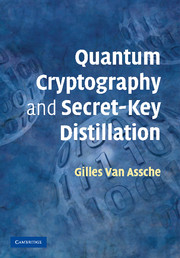Book contents
- Frontmatter
- Contents
- Foreword
- Preface
- Acknowledgments
- 1 Introduction
- 2 Classical cryptography
- 3 Information theory
- 4 Quantum information theory
- 5 Cryptosystems based on quantum key distribution
- 6 General results on secret-key distillation
- 7 Privacy amplification using hash functions
- 8 Reconciliation
- 9 Non-binary reconciliation
- 10 The BB84 protocol
- 11 Protocols with continuous variables
- 12 Security analysis of quantum key distribution
- Appendix symbols and abbreviations
- Bibliography
- Index
12 - Security analysis of quantum key distribution
Published online by Cambridge University Press: 04 August 2010
- Frontmatter
- Contents
- Foreword
- Preface
- Acknowledgments
- 1 Introduction
- 2 Classical cryptography
- 3 Information theory
- 4 Quantum information theory
- 5 Cryptosystems based on quantum key distribution
- 6 General results on secret-key distillation
- 7 Privacy amplification using hash functions
- 8 Reconciliation
- 9 Non-binary reconciliation
- 10 The BB84 protocol
- 11 Protocols with continuous variables
- 12 Security analysis of quantum key distribution
- Appendix symbols and abbreviations
- Bibliography
- Index
Summary
So far, the knowledge of Eve has been modeled by a classical random variable. The aim of this chapter is first to discuss how the previous results apply to QKD, where Eve's action may not necessarily be classically described by the random variable Z. Then, we explain the equivalence between BB84 and so-called entanglement purification protocols as a tool to encompass general eavesdropping strategies. Finally, we apply this equivalence to the case of the coherent-state protocol GG02.
Eavesdropping strategies and secret-key distillation
In Chapters 10 and 11, I analyzed the security of the protocols with regard to individual eavesdropping strategies only. In this particular case, the result of Alice's, Bob's and Eve's measurements can be described classically and the results of Section 6.4 apply. Let us review other kinds of eavesdropping strategies and discuss how the concepts of Chapter 6 can be applied.
Note that the individual eavesdropping strategy, the simplest class of strategies, is still technologically very challenging to achieve today in an optimal way. Nevertheless, we do not want the security of quantum cryptography to rely only on technological barriers. By considering more general eavesdropping strategies, we make sure quantum cryptography lies on strong grounds.
Following Gisin et al. [64], we divide the possible eavesdropping strategies into three categories: individual attacks, collective attacks and joint attacks.
- Type
- Chapter
- Information
- Quantum Cryptography and Secret-Key Distillation , pp. 205 - 244Publisher: Cambridge University PressPrint publication year: 2006
- 1
- Cited by



